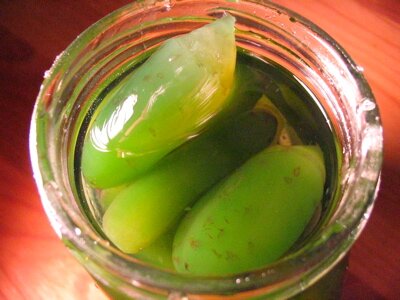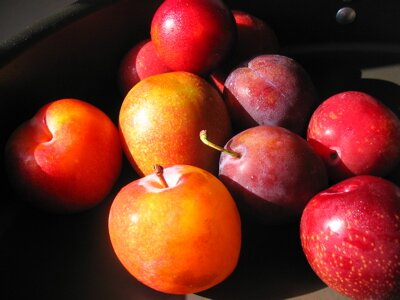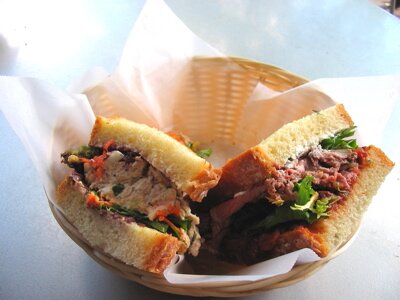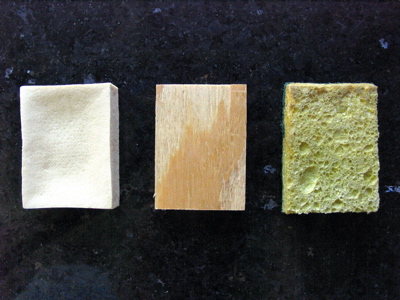
England was a carnival of meat, starting with the hanging game at Borough Market, much of it with fur and feathers still intact, and ending with the aseptic white of St. JOHN in Smithfields.
Borough Market on the first day was quite envy inducing, which is something, considering that I’ve got Union Square. The winter selection here was somewhat better than at Union, with one vegetable supplier, Turnips, fully stocked. I don’t know where they got their stuff, but much of it was in at least decent shape, including, somehow, tomatoes that actually smelled edible. A baker was present, as were several confectioners, mostly dealing in chocolates of reasonable quality, but one with trays and trays of dried fruit, nuts, and Turkish delight which I might have sold an acquaintance for. Cheesemongers were limited in both scope and quality, probably discouraged by the proximity of Neal’s Yard Dairy. Mostly, though, there was meat.
At least three huge butchers were set up, each stall at least as big as Mario’s store, selling heritage meats and their own charcuterie. At least one more was closed for New Year’s Eve. All dealt in both beef and pork, with game being available in varying quantities. Mostly there were cooking cuts on display, but with tantalizing promises that primal cuts were available too. Fresh hams and huge, lightly cured pork chops seemed to be the biggest sellers. A woman, calling herself Hunter Gatherer Foods, sold salumi from Iberian pigs - the spicing was relatively light, so the fermentation and meat could be tasted more clearly. One particularly ambitious operation combined a fishmonger with an impressive 10’ high rack of hares, pheasants, partridges, geese, and skinned does, all of which were hanging for future sale. When you got close, the dead hares stared back with blood-soused eyes.
Lunch was half of one of Mrs. Elizabeth King’s meat pies, eaten at room temperature. The pie was traditional, with a raised crust (meaning it was made with hot water, and stood vertically, without the support of the pie dish), and my half must have weighed near a pound. Inside was wild game, ground with a little too much sage and pepper, set in truly luscious aspic. Still, you could taste the meat (venison and wild boar, probably no hare), and, wonder of wonders, it was relatively lean. I would have gotten pork, but they were out. My companion, unashamedly bourgeois, left wing and artistic, had boar and cranberries in his. As we ate, we watched the most beautiful meat slicer I’d ever seen, a hand cranked, cast iron contraption, big as a car engine. Every portion of it was either scarlet, black iron, or gleaming steel, and I’d bet it’s been running since before my da got to London.
Lunch finished with gooseberries, damn good, from Turnips, and a cup of Monmouth Coffee. If I ever open a café, it will serve coffee just the way the Monmouth Coffee Company does, or not at all. As I got in line for a cup of daily brew, I noticed a curious rack with a number of porcelain drip cones arranged in it, apparently for display. I ordered, then stared open mouthed as the barista ground a portion into a paper filter, stuck it in a porcelain cone, then slowly added water which was 10 seconds off the boil.
“Wait,” I asked, “are you actually brewing me a cup of drip coffee, right now?”
“You ordered one, didn’t you?”
The coffee was roasted slightly dark for me, but it didn’t really matter, after that.
Sadly, nothing else in England managed to match that first, brilliant trip to the market, except dinner at St. JOHN. St. JOHN is where Fergus Henderson perpetrates “a sort of British cooking”, which involves a great many bits of animal you might not have considered putting in your mouth. The experience goes well beyond the food – it’s steps away from Smithfield market, which is to meat what Tsukiji is to fish. As you walk to dinner, you pass butchers cutting down sides of pork, and the curious, bloodless smell of fresh meat hangs in the air. The place itself is whitewashed inside and out. Anything that isn’t bare concrete is fastidiously, serenely white, and the high ceilings, naked piping, and more white make it feel almost oppressive, like he’s daring you to call it gorgeous. It’s a relaxed room pretending to be tense. Even the typography is a quiet rebellion, Times New Roman in a city of Gill Sans.
My companions were unimpressed by the menu. Faced with a menu featuring grey partridge, lamb’s tongues, goose gizzards, marrow bones, chitterlings, smoked eel and venison offal, they found they were tempted by pot roast pork, langoustines and steamed hake. Yet, in the presence of our server, a very small woman in a very big jacket (white) with very long glasses (black) and a great deal of hair (blond) pulled very severely back, they mysteriously rediscovered their gustatory backbones. Perhaps her descriptions sounded tempting – chitterlings grilled, after a bath in an English mustard marinade, grey partridge very nice, marrow bones a signature, invariably superb – as one friend pointed out, with this menu, they could hardly afford to have staff who didn’t actually like the food they served. More likely it was her steely gaze and imperial voice reminded them that people come here to be brave. Had I asked I’m sure her name would have turned out to be Millicent or Mildred or something similar.
In the end, no langoustines shamed our table. We started with lamb’s tongue salad (much like other tongues, with a distinct touch of sweetness), pressed pork and goose gizzards (a terrine, beautiful – whole gizzards buried in very finely shredded pork, surprisingly delicate flavour, lovely texture), and roasted marrow bones (I’d had marrow, but never saw the point before. This was unbelievably good). Pot roast Gloucester Old Spot had been smoked beforehand, and so, while very well done, wasn’t quite the act of worship the meat deserved. Venison offal – a tiny kidney and slices of liver, was faintly, pleasantly gamy, offset by a deep yet vinegary pan sauce, and beets. The kidney was actually tasty, which again, was more than I could say about the other kidneys I’ve had. The menu listed a marmalade pudding for two, which our server said was enough for three. The monster that arrived on the table, along with a half-litre of warm custard, could have fed eight of us. I’d asked for it because I have a recipe for such a thing at home, and wanted to know what one should actually taste like before making mine – the education turned out to be tangential, because this one had the marmalade over the top, whereas my recipe calls for it to be mixed right in. I did, however, learn that custard, flavoured with vanilla and a touch of nutmeg, is absolutely essential.







